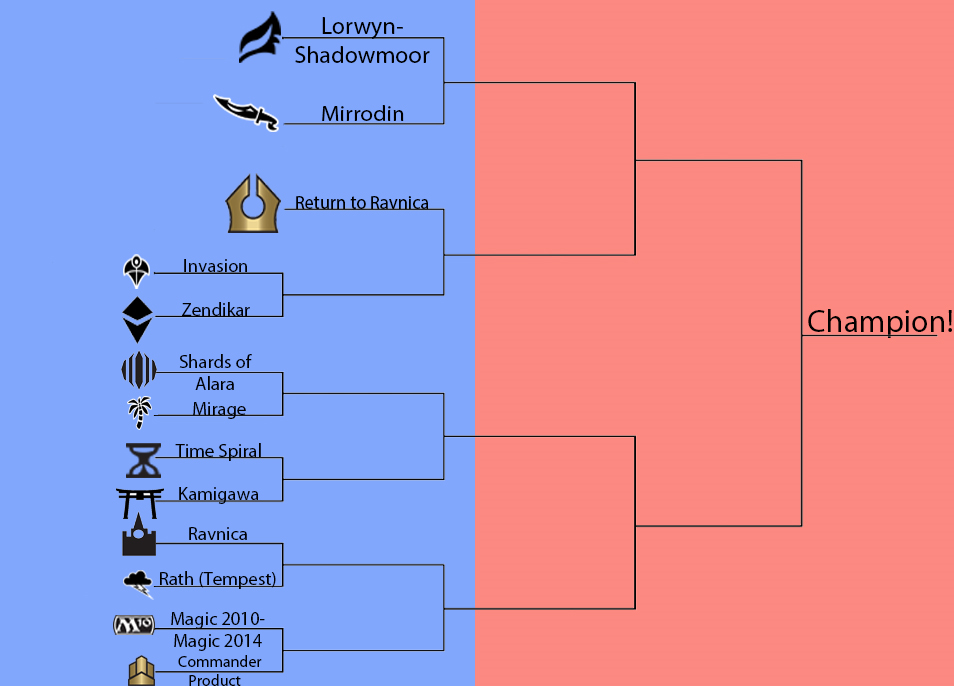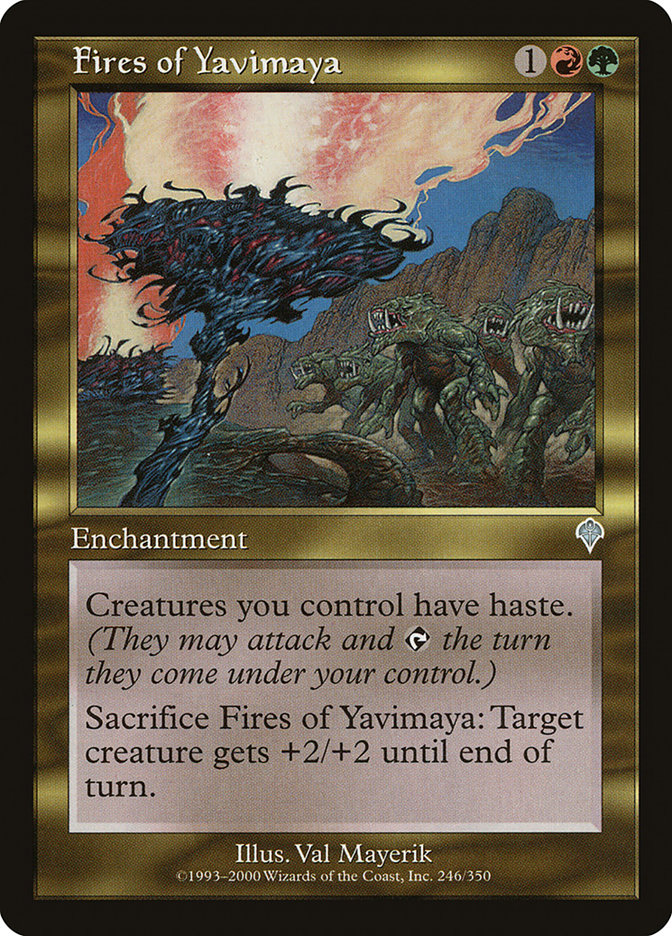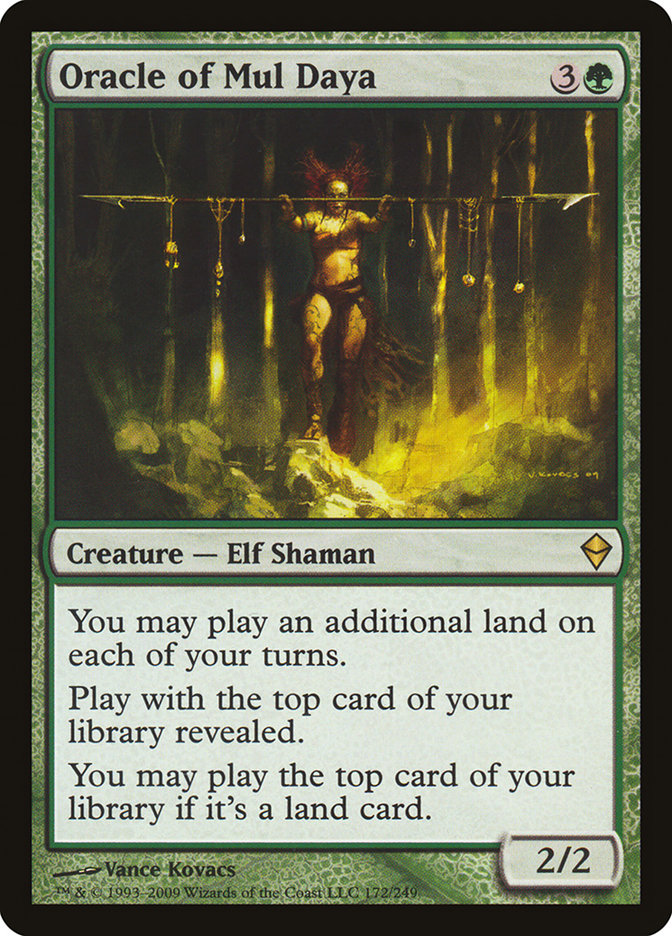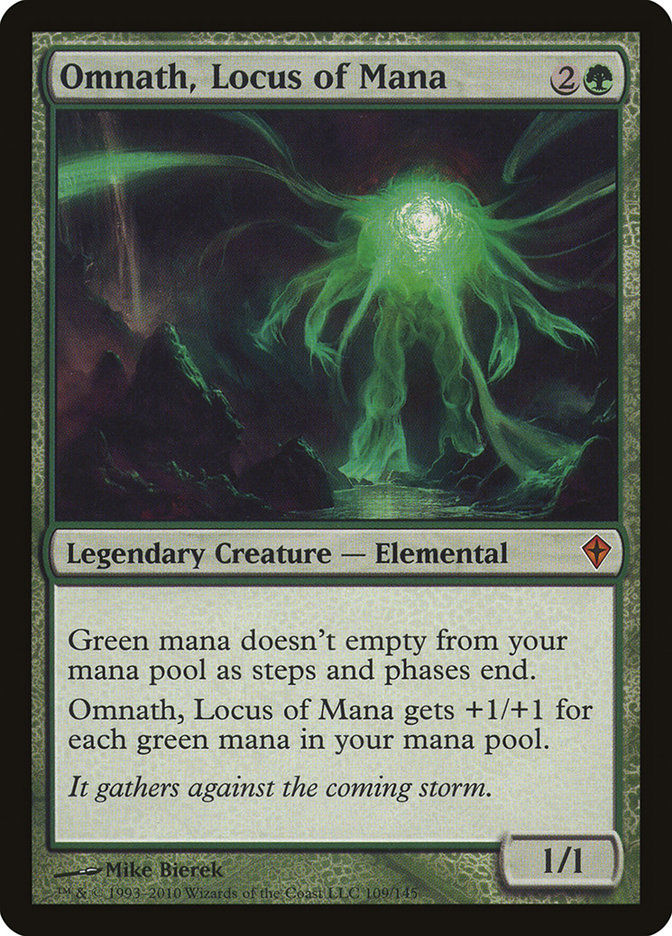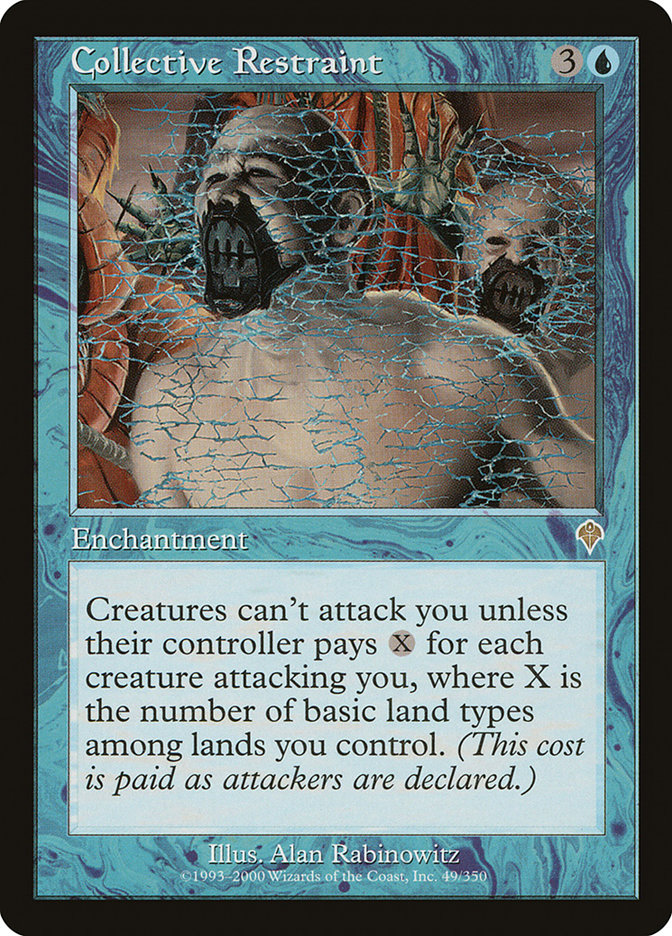This installment of Battle Of The Blocks throws untested challenger Zendikar block into the ring against multicolored behemoth Invasion block. The brainchild of head designer Mark Rosewater, Zendikar block focused on a previously untested theme: lands. Utilizing mechanics like landfall and multikicker, Zendikar block pushed the "lands matter" concept to its fullest, delivering interesting card designs and important nonbasics.
The third set of Zendikar block, Rise of the Eldrazi, furthered this "lands matter" theme with the splashy colorless Eldrazi creatures and a new mechanic called level up, each forcing the player to prioritize land drops in order to garner the full effect from their spells. When looking at this block from a Commander perspective, the nonbasic lands and awesome themes like Allies come to the forefront and make a solid case for its high seed in the Battle Of The Blocks tournament.
Returning to the battlefield like a Flametongue Kavu off of Astral Slide, Invasion block brings the heat. Pairing inventive multicolored spells with strong tribal themes, Invasion block continued the story of Gerrard Capashen and the Weatherlight crew as they defended the multiverse against the Phyrexian scourge. Invasion block was one of the first blocks to truly utilize enemy color pairings, establishing design space for years to come with spells like Prophetic Bolt and Death Grasp.
It soon expanded these color pairs into tricolored shards and wedges, establishing a resonant identity for these tricolor groupings and furthering the development of the entire game with its bold development decisions. In its last battle against the poisonous Scars of Mirrodin block, the strength of Invasion block’s individual cards and lack of infect pulled it ahead of the oil-ridden Scars of Mirrodin, securing its spot in today’s battle.
Before we fully dive into these two blocks, let’s take a quick look at the updated bracket:
The winner of this battle will go on to try to take down city-bound Return to Ravnica block and advance to the Top 4 of the Battle Of The Block competition! Remember, these battles are to decide which block contributed the most to Commander, not the best block in all of Magic. They will be compared in the usual five categories: Staples, Commanders, Strategies, Flavor, and The Bad.
Staples
Five Notable Staples From Invasion Block
1) Phyrexian Arena
2) Fires of Yavimaya
3) Vindicate
4) Fact or Fiction
5) Hull Breach
Drawing cards for one life has been in black’s wheelhouse since Ice Age, and its strength is put on display with Phyrexian Arena. For the small investment of three mana, Phyrexian Arena returns dividends over the course of an entire Commander game, drawing ten or more cards and barely scraping the starting 40 life total. Both Fires of Yavimaya and Hull Breach are perfectly designed red-green cards that represent the power of the color pairing and find their inclusion in most decks playing the Gruul. The absolute efficiency of Hull Breach to destroy the high-impact artifacts and enchantments of Commander is the reason it grabs the number five spot and an inclusion in most red-green decks.
Fires of Yavimaya is also instrumental for Gruul-colored Commander decks to combat board wipes from control decks by severely limiting the amount of time an opposing deck has to react to their imposing threats. I spoke of the virtues of Fact or Fiction in the last battle with Invasion block, but its inclusion in Commander decks is still prevalent and the decisions it creates in a game state are still some of my favorites.
Five Notable staples From Zendikar Block
1) Enemy-Color Fetch Lands
2) Oracle of Mul Daya
3) Stoneforge Mystic
4) Day of Judgment
5) Rite of Replication
One of the first cards revealed from Zendikar block was Arid Mesa, heralding the arrival of enemy-colored fetch lands. Fetch lands are extremely important in upgraded mana bases because of their unique ability to extract nonbasic lands from the deck, adding both utility and strength to a multicolored mana base. Stoneforge Mystic brings a toolbox feel to any deck it is a part of through its cheap tutor effect for the most impactful Equipment in a specific board state. A Stoneforge Mystic is only as strong as the Equipment placed around it, so if the best Equipment in the deck is Bonesaw adding Stoneforge Mystic to the deck may not be worth it.
Oracle of Mul Daya, Day of Judgment, and Rite of Replication are spells that have had a lasting impact on the format. Oracle of Mul Daya is an amazing accelerator for any green deck because it enables decks to motor out their lands while sculpting the best draw for a game state. Day of Judgment is Wrath of God’s little brother, but it still prevents slower decks from becoming overrun by aggressive red or green strategies and increases the consistency of a controlling white deck. Rite of Replication is a legitimate win condition and has only gotten better with age as splashier creatures with better enter-the-battlefield abilities have been created.
When looking at these two blocks side by side, there are a myriad of staples that stand out as important cards for the current Commander metagame. But the power of Invasion block is outmatched by fresh-faced Zendikar block because of Zendikar block’s deeper cuts like All Is Dust, Terastodon, and many others. This category is extremely close, but Zendikar wins it by a hair.
Commanders
With the introduction of Rise of the Eldrazi, Commander received three new colorless commanders to complement Karn, Silver Golem in the legendary trio of Eldrazi: Ulamog, the Infinite Gyre; Kozilek, Butcher of Truth; and Emrakul, the Aeons Torn. Emrakul’s Time Walk effect with the annihilator mechanic caused it to become banned in Commander, leaving its little brothers Kozilek and Ulamog to take the reigns as strong colorless commanders for the format. The addition of more colorless generals to the format did strengthen the presence of these types of decks, carving out a small colorless niche in Commander.
Zendikar also brought some very popular legends to the kitchen table with the printing of Omnath, Locus of Mana and Wrexial, the Risen Deep. Omnath, Locus of Mana provided a new style of mono-green deck that uses its general as both the main engine and one of the strongest win conditions. Utilizing Omnath’s Upwelling effect correctly is an interesting and unique dynamic the legendary Elemental brings to the table, forcing players to enter into a constant balancing act between casting spells and attacking for monumental amounts of damage.
Wrexial the Risen Deep reminded people to unleash the Kraken, and enterprising deckbuilders have created multiple different shells for this legend, from a "Marine Biology" deck that plays Leviathans and Squids to a controlling blue black deck that lives out of everyone’s graveyard.
When looking at Invasion block, I really want to focus on the Invasion Block Dragons for their importance in the early Commander format. The Invasion block Dragons were the most important shard-based commanders for about three years after the original Elder Dragons fell out of favor due to their wonky abilities and high converted mana costs. Until Shards of Alara came out and gave the Commander community some new options, the go-to generals in both Grixis and Naya colors were Rith, the Awakener and Crosis, the Purger.
Rith, the Awakener is the perfect general for a red, green, and white token deck because he battles as a huge six-power flier in the air while creating a horde of Saproling tokens on the ground to keep the player safe from a counterattack. This forces opponents to either deal with the evasive threat or the huge writhing mass of tokens on the ground. Crosis, the Purger complemented red, black, and blue decks well by demolishing monocolored decks and being a large body that could block the huge creatures out of green or red.
Between Zendikar block and Invasion block, this category is rather close due to the expansion of colorless decks from Zendikar versus the strong generals from Invasion block. The deciding factor for this category is that Invasion block brought more than a couple of Dragons to the fight—it also has Captain Sisay; Hanna, Ship’s Navigator; and Cromat to fill out its inclusions to the Commander format and grabs this category!
Strategies
This category highlights the established and lesser-known strategies that each block propels into the spotlight. Invasion block’s strong multicolored theme did wonders for creating new cards that helped establish specific strategies in defined colors. A great example of this is Phyrexian Tyranny, a card that is instrumental in the painful wheel strategy to force your opponent to lose life while drawing cards and establishes this punisher-based approach within the Grixis colors.
This multicolored block was peppered with some tribal spells in the ringleader cycle that brings an element of card advantage to these creature type-based decks. The final strategy that loves Invasion block are "pillow fort" decks that utilize enchantments like Teferi’s Moat and Collective Restraint to force opponents to pay tons of mana to attack them.
Zendikar block focused on lands with its great amount of nonbasics throughout all three sets and the awesome landfall mechanic. Lands like Valakut, the Molten Pinnacle bolstered mono-red strategies with a free Searing Spear every turn in the late game, while Oran-Rief, the Vastwood has become a staple in token-based decks. Beyond Oran-Rief, token-based decks also grabbed the rebounding Nomad’s Assembly and the powerful Avenger of Zendikar to finish off games.
The Ally tribe broke on to the scene in this block with such notables as Sea Gate Loremaster and Turntimber Ranger incentivizing players to enter into the crazy world of five-color tribal. Two other important cards from this block are the bizarre Bazaar Trader and Keening Stone. Bazaar Trader makes the Donate deck an actual strategy, while Keening Stone is one of the best finishers for the mill deck.
Once again these two blocks are neck and neck at the end of a category, but with spells like Keening Stone and Stoneforge Mystic, Zendikar block narrowly pulls this section away.
Flavor
The Weatherlight saga will be forever known as the journey of Gerrard Capashen and the Weatherlight crew around the multiverse to save every living thing from the horrors of Phyrexia. This set finally delivered the punch players had been waiting for with the armies of Yawgmoth attacking en masse to destroy the forces of good. This section essentially rewards fantastic card design that brings a board state to life through the combination of what the card does with what the card depicts. Invasion block does this beautifully with spells like Urza’s Guilt and Phyrexian Arena that not only bring a punch to the battlefield but tell a story through their art style and effects.
Zendikar block’s flavor is disjointed because of the final set, Rise of the Eldrazi. In Zendikar and Worldwake, the card design is based around grand voyages and allies taking on quests to find hidden treasures. Cards like Lavaball Trap and Quest for the Holy Relic really showcase this explorer theme and drive home the flavor of the first two sets, yet everything changed once the Eldrazi were released.
With the printing of Rise of the Eldrazi, the block’s focus turned to these monumental beings of destruction that were unleashed upon the landscape of Zendikar. Spells like All Is Dust and Growth Spasm tell the story of a plane overrun by these colorless monsters and deviates heavily from the flavor of Zendikar and Worldwake. When on the battlefield the Eldrazi are just as splashy, but they don’t evoke the actual feeling of two-thirds of Zendikar block; instead they are Cthulhu-like creatures of wanton destruction.
Zendikar block’s schizophrenic flavor of monstrous beings and adventuring allies causes it to lose this category to Invasion block’s fantastic storytelling of the invasion and eventual destruction of the Phyrexian leader Yawgmoth.
The Bad
The most damaging thing to come from Zendikar block was the Eldrazi and the annihilator mechanic. In a fair format, the Eldrazi don’t arrive until turn 10 or 12 or even 15, but Commander is not a fair format, so the Eldrazi come down much quicker than a double-digit turn. The banned Emrakul, the Aeons Torn was the worst offender because it not only gave players an evasive monumental threat but also an extra turn!
The annihilator mechanic, which forces the defending player to sacrifice permanents when attacked by the Eldrazi, also compounds the pain of an early twelve-power creature. Not only is twelve power coming directly at the player, but in either an early- or late-game scenario, lands are the permanents being sacrificed, delaying the opportunity to combat the monster slamming for the life total.
When looking at Invasion block, the only card that negatively affected the format was Coalition Victory because it was an honest automatic win condition in five-color decks, but that card was quickly banned.
The rest of Invasion block doesn’t offer up any other cards that have negatively impacted Commander, and Invasion block wins this section due to its low negative impact on the format.
These two blocks are the closest in power level and the hardest to determine a true winner from. Zendikar block brought Commander players the Ally tribe; great staples like Rite of Replication, Avenger of Zendikar, and All Is Dust; and fantastic generals like Thada Adel, Acquisitor and Omnath, Locus of Mana. Invasion block still contributed some of the strongest staples of any block as well as helped the format in its earliest form.
When looking at the two blocks side by side, the one that the Commander format would be hurt the most in not having would be Zendikar block, and it is the winner of this week’s Battle Of The Blocks! Even with the annoyance that the Eldrazi bring to the battlefield, Commander would be in a much worse state if it didn’t have the nonbasics from Zendikar and fun spells like Rite of Replication to create amazing board states.
This battle was extremely close, so if you think Invasion block should have won or you agree with my decision let me know in the comments below. It was really close, but I believe that Zendikar is the better block and deserves to move on in the bracket.

